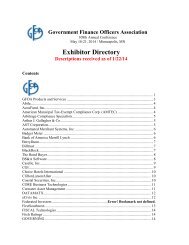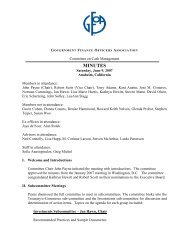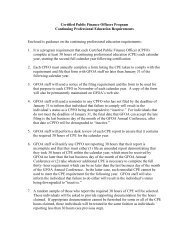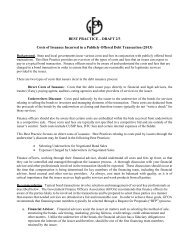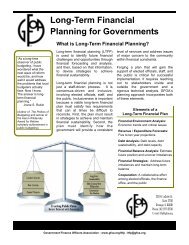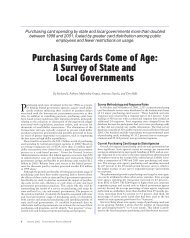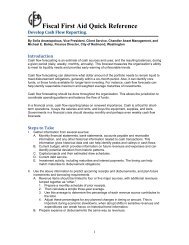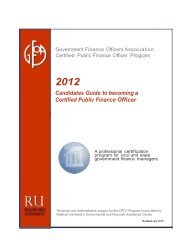PubliC-SECtor PEnSion PlanS Major Challenges & Common-Sense ...
PubliC-SECtor PEnSion PlanS Major Challenges & Common-Sense ...
PubliC-SECtor PEnSion PlanS Major Challenges & Common-Sense ...
Create successful ePaper yourself
Turn your PDF publications into a flip-book with our unique Google optimized e-Paper software.
Public-Sector Pension Plans<br />
<strong>Major</strong> <strong>Challenges</strong> & <strong>Common</strong>-<strong>Sense</strong> Solutions<br />
By Kim Nicholl
Ensuring that state and local pension plan funding will<br />
be adequate to support promised benefits is a critical<br />
task for policymakers. Assessing funding adequacy<br />
starts with having a reliable measure of the plan’s cost, in<br />
both the short and long term. For a defined benefit pension<br />
plan, an actuarial funding policy determines the ultimate<br />
cost of the plan and how much of that cost should be contributed<br />
in the current year. Then, if actual contributions are<br />
less than the actuarially determined cost, at the most basic<br />
level two options are available: 1) reduce the cost of pensions<br />
by restructuring benefits, and/or 2) increase the amount<br />
that public employers (i.e., taxpayers) and/or employees<br />
contribute to the plan. In some jurisdictions, modest changes<br />
in benefits or contributions will be sufficient to fill the<br />
gap, but in others, often where unfunded liabilities are large,<br />
more substantial revisions will be required.<br />
ACHIEVING BALANCE<br />
Stakeholders have different priorities<br />
and will naturally advocate<br />
reforms that reflect those priorities.<br />
Taxpayer organizations tend to focus<br />
more on paring back pension benefits<br />
in order to reduce pension costs,<br />
while employee groups, concerned<br />
about their ability to achieve a secure<br />
retirement, often prioritize increased<br />
plan funding.<br />
Assessing funding adequacy starts<br />
with having a reliable measure of<br />
the plan’s cost, in both the short and<br />
long term.<br />
pension benefits with broad public policy goals, rather than<br />
narrow interests. These goals might include transparency,<br />
budgetary predictability, benefit affordability, retirement<br />
security, intergenerational equity, and the provision of highquality<br />
public services. While it might seem impossible to<br />
meet all these objectives simultaneously, policymakers can<br />
rely on some common-sense principles to maximize their<br />
chances of achieving balance among competing aims.<br />
A COMMON-SENSE APPROACH<br />
Before delving into the details of pension funding policy,<br />
it is important to clarify that state and local pensions are<br />
pre-funded, as opposed to pay-as-you-go retirement systems<br />
like Social Security. In pay-as-you-go systems, contributions<br />
from current employees are used to pay benefits for current<br />
retirees. In pre-funded systems, the employer and employee<br />
make contributions into a pension trust each year, over the<br />
course of an employee’s working life.<br />
That money is invested and earnings<br />
on these funds are re-invested. By<br />
the time the employee reaches retirement,<br />
the accumulated assets in the<br />
trust are available to pay benefits. The<br />
objective, of course, is to accumulate<br />
sufficient assets to pay the benefits<br />
over the remainder of the employee’s<br />
life, and any beneficiary’s life as well.<br />
A balanced approach is more likely to achieve success<br />
than an either-or proposition. Each group of public pension<br />
stakeholders has legitimate objectives. Taxpayer concerns<br />
about the affordability of pension benefits and employee<br />
concerns about having sufficient retirement income are both<br />
valid. And both groups should share an interest in seeing<br />
that sound pension funding principles are being followed.<br />
Beyond these considerations, public employers have their<br />
own workforce management objectives — they want to<br />
ensure that the pension benefit, as part of an overall compensation<br />
package, supports their efforts to hire and retain<br />
talented employees. If they are to address the needs of all<br />
parties in the long term, reform efforts must take all these<br />
priorities into consideration.<br />
The best way to achieve balance among stakeholder priorities<br />
is to align the policies governing pension funding and<br />
To meet this objective, a pension plan should receive contributions<br />
in accordance with an actuarially based funding<br />
policy. The funding policy determines exactly how much<br />
the employer and employee should contribute each year to<br />
ensure that the benefits being earned will be securely funded<br />
in a systematic fashion.<br />
A comprehensive and actuarially well-designed funding<br />
policy supports three key policy goals: predictable costs for<br />
employers, secure benefit payments for members, and intergenerational<br />
equity across different groups of taxpayers.<br />
Predictable Costs for Employers. If pension contributions<br />
fluctuate wildly from one year to the next, the result<br />
is budget chaos. That creates problems for all stakeholders.<br />
Thus, a funding policy should be purposely designed to<br />
develop costs that are expected to bear a reasonable relation-<br />
April 2013 | Government Finance Review 9
ship to payroll and to manage and control contribution volatility.<br />
A comprehensive funding policy has several moving<br />
parts, including an actuarial cost method, asset-smoothing<br />
techniques, and the manner in which any unfunded liabilities<br />
are amortized. A plan’s specific choices for each of these<br />
policy components will have a bearing on whether employer<br />
pension contributions will be more predictable or more volatile.<br />
In addition, contributions must be based on actuarial<br />
assumptions, both demographic and economic, that reflect<br />
the best possible estimates of future experience.<br />
The actuarial cost method refers to the manner in which the<br />
total present value of all future benefits for current active participants<br />
is allocated to each year of service. Asset-smoothing<br />
techniques are a tool used to manage the effect of investment<br />
volatility on contributions and to provide a more consistent<br />
measure of plan funding over time. Financial markets have<br />
considerable short-term volatility, but pension plans have<br />
long investment and benefit horizons. Asset-smoothing methods<br />
are used to reduce the effect of that short-term market<br />
volatility on contributions, while still tracking the changes in<br />
the market value of plan assets. They do this by recognizing<br />
the effects of investment gains and losses over a period of<br />
years, instead of immediately when they occur. Amortization<br />
of unfunded liabilities refers to the manner in which the current<br />
and future unfunded liabilities are systematically funded,<br />
or “paid off,” over time.<br />
While a detailed review of these complex issues is beyond<br />
the scope of this article, it is important to note the following<br />
general rules. 1 The “entry age normal” actuarial cost method<br />
tends to recognize actuarial liabilities sooner and tends to<br />
result in a more stable normal cost pattern over time, as compared<br />
with other methods (such as<br />
the “projected unit credit” method).<br />
and controlling contribution volatility for plan sponsors.<br />
Amortizing unfunded liabilities over longer periods will lead<br />
to less volatility in contributions, but excessively long periods<br />
may inappropriately shift costs to future generations. Plan<br />
sponsors must find a balance between controlling contribution<br />
volatility and ensuring that costs are not unfairly shifted<br />
to future generations of taxpayers.<br />
Secure Benefit Payments for Members. The plan exists<br />
to pay benefits. For that reason, funding policies are designed<br />
to accumulate assets over time that will provide for all the<br />
benefits that have been and will be earned by plan participants.<br />
An actuarially determined funding policy generally<br />
supports this goal.<br />
In some instances, employers’ annual contribution rates<br />
are fixed by statute or otherwise not determined by strict<br />
adherence to a funding policy. Fixed contributions have<br />
the benefit of being very predictable, but they can pose<br />
risks by falling short of the actuarially determined needs<br />
of the pension plan, increasing unfunded liabilities. This is<br />
especially true when the plan has a limited ability to adjust<br />
benefits. Even in cases where the contribution rate, as<br />
originally established, was actuarially determined, changes<br />
in the plan or plan experience (e.g., benefit improvements,<br />
mortality improvements, and/or asset losses) can cause the<br />
fixed contribution rate to become insufficient for the plan<br />
to achieve its goal of paying all benefits when due. The<br />
result could be a rapid, unexpected escalation in actuarially<br />
required contributions, thereby adding to the employer’s<br />
fiscal commitments.<br />
Intergenerational Equity across Groups of Taxpayers.<br />
The goal of fairly sharing plan costs across generations of<br />
taxpayers is achieved by adopting a<br />
funding policy that ensures that the<br />
Determining the ideal asset-smoothing<br />
policy involves a balance between<br />
The best way to achieve balance<br />
among stakeholder priorities is to<br />
cost of pension benefits is reasonably<br />
allocated to the years of service<br />
controlling market volatility (by using<br />
worked by employees. A funding<br />
align the policies governing pension<br />
longer smoothing periods) and making<br />
sure the smoothed asset value funding and pension benefits with of benefit improvements is recog-<br />
policy can help ensure that the cost<br />
maintains a reasonable relationship broad public policy goals, rather nized and paid for during the working<br />
careers of those who will receive<br />
to the actual market value. Amortizing<br />
than narrow interests.<br />
unfunded liabilities involves balancing<br />
them, without unfairly burdening the<br />
the two goals of ensuring fair-<br />
ness across generations of taxpayers<br />
current taxpayers for events beyond<br />
their control.<br />
10 Government Finance Review | April 2013
As noted previously, the objective of intergenerational equity<br />
provides a “check” to ensure that the goal of predictable<br />
contributions does not override all other concerns. Longer<br />
asset-smoothing and amortization periods help reduce contribution<br />
volatility, but by doing so, current taxpayers may be<br />
deferring costs to future generations of taxpayers. A balanced<br />
funding policy will find a “sweet spot” between these two<br />
important policy goals.<br />
Once the plan sponsor has established the elements of a<br />
comprehensive funding policy and put it into effect, stakeholders<br />
should be able to understand the cost of pension<br />
benefits and develop a realistic plan for paying those costs<br />
over time. In many cases, stakeholders will be reassured<br />
about the path they have been following to meet future commitments.<br />
But sometimes, pension trustees, employers, and/<br />
or policymakers may discover that the commitments they<br />
have made in the past are not enough, and the plan will<br />
require greater contributions. Still others may find that their<br />
commitments are no longer affordable when considered in<br />
the context of the overall state or local budget and that benefits<br />
need to be reevaluated. In any of these scenarios, officials<br />
may also conclude that having a comprehensive statement<br />
of their funding policy in a single document is advantageous.<br />
A well-conceived funding policy can do more than ensure a<br />
well-funded plan — it can enlighten benefit policy.<br />
COST — AND OTHER — CONSIDERATIONS<br />
In the current environment, state and local governments’<br />
reexamination of their pension programs is being driven<br />
primarily by cost considerations. But there are other good<br />
reasons to review pension benefit policy periodically. These<br />
include assessing how economic risks are shared between<br />
employers and employees, reviewing the extent to which<br />
benefits provide an adequate retirement income, and ensuring<br />
that the plan is still meeting the workforce management<br />
goals of the employer, including employee attraction, retention,<br />
and retirement patterns.<br />
State and local officials nationwide are focused overwhelmingly<br />
on the question of whether existing pension<br />
plans are affordable or sustainable, given new fiscal realities.<br />
There are many ways to achieve the goal of reducing pension<br />
costs, but some changes have a greater impact than others.<br />
Shorthand images or metaphors can help when ranking or<br />
prioritizing changes according to their financial impact. For<br />
example, changes with the largest impact on cost can be<br />
thought of as “boulders.” These might include eliminating<br />
cost of living adjustments or changing the basic design of<br />
benefits. Changes with large but less significant effects are<br />
“rocks.” This category could include reforms such as modifying<br />
cost of living adjustments, increasing retirement ages, and<br />
changing eligibility rules or benefit formulas for current and<br />
future employees. Modest-impact changes can be thought<br />
of as “pebbles,” and those with the smallest effects, “sand.”<br />
Increasing the final average salary period use for calculating<br />
benefits from three or five years to five or seven years would<br />
fall into this category, as would reductions to disability and<br />
death benefits. Stakeholders can use this imagery to help<br />
them stay focused on changes that will make a real difference,<br />
and avoid being unduly distracted by modifications<br />
that might not ultimately address the core question of affordability.<br />
DISTRIBUTION OF RISK<br />
The type of retirement plan offered — a traditional defined<br />
benefit pension plan, a defined contribution savings plan,<br />
or a hybrid plan, which combines elements of DB and DC<br />
plans — has great bearing on how risks are distributed.<br />
Indeed, recent economic events have reminded employers<br />
April 2013 | Government Finance Review 11
that investment risk and the resulting contribution volatility<br />
risk have significant economic consequences.<br />
DB and DC plans differ in how they allocate risks, including<br />
investment risk, inflation risk, contribution risk, and longevity<br />
risk. Under a DB plan, the employer bears the bulk of these<br />
risks. For example, if life expectancy increases, employer contributions<br />
will need to increase as well to cover the benefit<br />
payments for longer periods. 2 Under a DC plan, the employee<br />
bears these risks while the employer may be exposed to other<br />
risks, particularly workforce management. If investment earnings<br />
fall short of expectations, employees will need to save<br />
more, delay their retirement, and/or modify their standard of<br />
living during retirement.<br />
Hybrid plans are designed to share risks between employers<br />
and employees by incorporating aspects of capitalaccumulation<br />
(DC) and income-replacement (DB) plans.<br />
In the public sector, hybrid plans are typically structured as<br />
combination plans in which employees earn a portion of<br />
their retirement benefit in a DB plan and also participate in<br />
a DC plan. Generally, the employer bears the risks for the DB<br />
portion of a hybrid plan and the employee bears the risks for<br />
the DC portion.<br />
Stakeholders may find it worthwhile to evaluate whether<br />
these risks are in their proper place and determine whether<br />
redistributing some of these risks is appropriate. This involves<br />
assessing which risks the plan or employers are in the best<br />
position to manage, and which ones employees can handle.<br />
Employees, with no opportunity to “pool” risk, may not be in<br />
the best position to bear the full brunt of investment, inflation,<br />
and — especially — longevity risks. There is also the matter of<br />
degree. For instance, employees might be able to bear some<br />
amount of contribution risk, but not all of it. A comprehensive<br />
benefit policy examines all aspects of risk and where it is<br />
most appropriately placed.<br />
Benefit Adequacy. Even though the stark fiscal environment<br />
is pushing cost and risk considerations to the forefront,<br />
stakeholders need to keep sight of benefit adequacy. After all,<br />
the goal of a retirement plan is to allow employers to attract<br />
and retain talent at a reasonable cost to the taxpayer by providing<br />
some level of retirement security to employees as part<br />
of a total compensation package.<br />
The “correct” benefit level should be based on objective<br />
analysis and subjective considerations. Benefit adequacy is<br />
typically assessed by calculating a “replacement ratio,” dividing<br />
the amount of retirement income a career employee would<br />
receive from the plan and from other income sources by the<br />
employee’s income just prior to retirement. Determining the<br />
“correct,” or target, replacement ratio involves some subjective<br />
calls such as defining a career employee and determining<br />
the age at which the target should be set. In addition, plan<br />
sponsors need to consider how the target should be set for<br />
public safety employees, given their unique work environment<br />
and demands. Another important consideration in<br />
evaluating benefit adequacy is the availability and cost of<br />
health care in retirement.<br />
A study conducted as part of Georgia State University’s<br />
Center for Risk Management and Insurance Research’s Retiree<br />
Income Replacement Project suggests that, as workers’ preretirement<br />
income ranges upward from $20,000 to $90,000,<br />
they will need a 94 percent to 78 percent replacement ratio<br />
to maintain a similar lifestyle in their post-retirement years. 3<br />
Social Security replaces 69 percent to 36 percent of preretirement<br />
compensation at these income levels. Therefore,<br />
the remainder needs to come from employer-sponsored<br />
pensions, employer-sponsored retirement savings plans, and<br />
12 Government Finance Review | April 2013
personal savings. For those publicsector<br />
employees who aren’t covered<br />
by Social Security (approximately 30<br />
percent of the state and local government<br />
workforce), 4<br />
the need for<br />
retirement income from an employersponsored<br />
plan and personal savings<br />
is greater, a fact that must be taken<br />
into consideration when setting benefit<br />
policy.<br />
Workforce Management Considerations. Employers<br />
offer benefit plans because such programs have been shown<br />
to aid in workforce management, supporting recruitment,<br />
retention, and the orderly retirement of employees. In general,<br />
employers can use plans that are designed to offer employees<br />
a more predictable benefit to accomplish workforce management<br />
goals, which include attracting experienced employees<br />
from the private sector, retaining talent, or facilitating orderly<br />
turnover through predictable retirements.<br />
Nevertheless, the implications of plan type on workforce<br />
management are sometimes overlooked. Conversely, changes<br />
in the workforce or in HR management objectives might<br />
prompt a reexamination of plan design to ensure that it is<br />
consistent with overall HR strategy.<br />
DB plan features can be used to encourage recruitment,<br />
retention, or retirement. Workforce management is more<br />
difficult with DC plans because account balances fluctuate<br />
with the financial markets, which can influence the timing<br />
of retirement beyond the control of the employer. In addition,<br />
the employer has little ability to encourage retirement<br />
through incentives if the existing DC plan balance will not<br />
support retirement income needs.<br />
Careful planning and quality analysis are the keys to designing<br />
a successful benefit policy. Making changes in a kneejerk<br />
fashion in response to the immediate budget or the political<br />
environment might address the narrow affordability question,<br />
but is unlikely to result in a retirement program that meets<br />
the long-term needs of employers, employees, or taxpayers.<br />
Equal caution should be exercised to avoid making changes<br />
to benefits in a vacuum. Rigorous analysis of existing data<br />
and forecasting of future trends are both invaluable in helping<br />
stakeholders determine whether proposed changes will<br />
Plan sponsors must find a balance<br />
between controlling contribution<br />
volatility and ensuring that costs<br />
are not unfairly shifted to future<br />
generations of taxpayers.<br />
accomplish their objectives and avoid<br />
unintended consequences.<br />
CONCLUSIONS<br />
When comprehensive funding and<br />
benefit policies are in place, they<br />
work hand in hand to reassure all<br />
stakeholders that pension plans are<br />
meeting broad public policy objectives.<br />
The choice is not either to focus<br />
on funding or to focus on benefits, but<br />
rather to do both, in a considered, deliberative manner.<br />
Stakeholders may not necessarily share the same objectives,<br />
or they may place different priorities on common<br />
objectives, but when it comes to pension reform, providing<br />
the opportunity for all voices to be heard enhances transparency<br />
and may improve the chances of stakeholder buy-in.<br />
The most successful and durable pension reform efforts are<br />
ones that strike a balance among recognizing employers’<br />
budget constraints, promoting responsible annual funding,<br />
and offering reasonable, secure benefits as part of a competitive<br />
overall compensation package. With comprehensive<br />
funding and benefit policies in place, pension plans will be<br />
well positioned to meet current challenges and to ensure that<br />
long-term goals are met as well. y<br />
Notes<br />
1. For a detailed examination of these issues, see “Planning a Successful<br />
Pension Funding Policy,” Segal Public Sector Letter, November 2011.<br />
2. Employees in some DB plans can bear a portion of these risks, if their<br />
contributions are adjusted to reflect the impact of the risks on plan costs<br />
(i.e., contribution rates that change based upon the actuarial valuation).<br />
3. These replacement ratios are noted on page ii of the 2008 GSU/Aon<br />
RETIRE Project Report, available at http://rmictr.gsu.edu/Papers/RR08-1.<br />
pdf.<br />
4. State and Local Government Retiree Benefits: Current Status of Benefit<br />
Structures, Protections, and Fiscal Outlook for Funding Future Costs, U.S.<br />
Government Accountability Office, 2007.<br />
KIM NICHOLL is a senior vice president and consulting actuary and<br />
the National Public Sector Retirement Practice leader of The Segal<br />
Company, based in the Chicago office. Nicholl is experienced with<br />
the design and interpretation of plan provisions for defined benefit<br />
and defined contribution retirement plans and on their relation to<br />
ERISA, IRS regulations, and new legislation, and her experience<br />
includes all aspects of employee benefit programs. She can be<br />
reached knicholl@segalco.com.<br />
April 2013 | Government Finance Review 13



